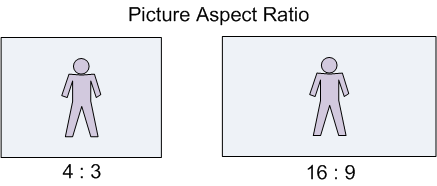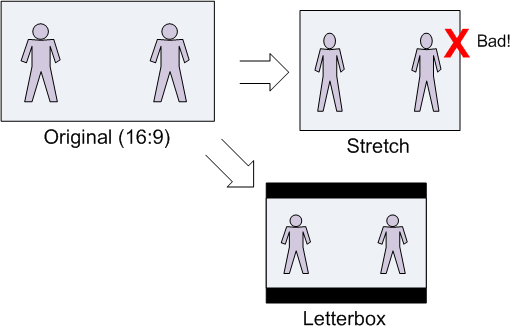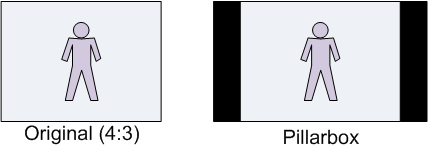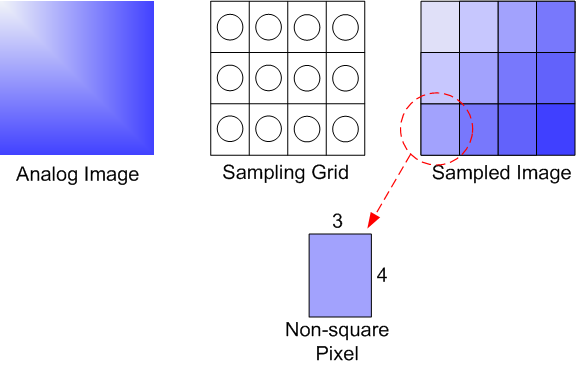官方英文文档链接:https://docs.microsoft.com/en-us/windows/desktop/medfound/picture-aspect-ratio
基于05/31/2018
In this article
此文介绍两个相似的概念,图片比例和像素比例。然后介绍如何在 media type 中使用。
Picture Aspect Ratio
Picture aspect ratio 表明了图片显示的形状。图片的长宽比表示为 X:Y,X 表示宽。大多数视频标准使用 4:3 或 16:9 的比例。16:9 通常称为宽屏(widescreen)。电影通常采用 1:85:1 或 1:66:1(?是不是1.85:1和1.66:1)。图片比例通常也称为 display aspect ratio (DAR).
有时候视频图像和显示区域的比例不一样。比如 4:3 的视频可能显示在 16:9 的显示器上。在电脑上,视频可能显示在任意大小的窗口中。在这种情况下,可以通过以下三种方式来使图像适应显示区域:
- 沿一个轴拉伸图像以适应显示区域。
- 缩放图像以适合显示区域,同时保持原始图片长宽比。
- 裁切图像。
拉伸图像以适应显示区域几乎总是错误的,因为它不能保留正确的图片长宽比。
Letterboxing
缩放宽屏图像以适应 4:3 显示区域的过程称为 letterboxing,如下图所示。图像顶部和底部的矩形区域通常为黑色,当然也可以是其他颜色。
相反,缩放 4:3 的图像以适应 16:9 显示区域的过程有时称为 pillarboxing。但是 letterbox 这个词也可以在其他各种情况下使用,意思就是缩放图像以适应任何给定的显示区域。
Pan-and-Scan
Pan-and-scan 是一种将宽屏图像裁切为 4:3 矩形图像的技术,用于在 4:3 设备上显示,生成的图像可以充满整个显示区域,但原图的一部分会被裁掉。这个区域可以根据不同的帧来决定,使图像一直包含比较重要的部分。“pan” 这个词主要是指显示区域在视频画面上横向移动。(译者的理解)
Pixel Aspect Ratio
Pixel aspect ratio (PAR) 表示像素的形状。
捕获数字图像时,将会从水平和竖直方向进行采样,从而生成一个称为像素(pixels or pels)的矩阵。采样网格的形状决定了图像中像素的形状。
下面是一个简单的示例。假设原始图像是正方形(即长宽比为 1:1),还假设采样网格(可以理解成相机传感器?)包含 12 个元素,排列成 4*3。所以生成的每个像素的形状,都是高度大于宽度,具体来说,每个像素的比例将是 3:4。非正方形的像素称为 non-square pixels。
像素长宽比也存在于显示在设备上。显示设备的物理性状和物理像素分辨率决定了 PAR。(电脑显示器通常是正方形像素)。如果图像的 PAR 和显示设备的 PAR 不匹配,则必须在一个维度(垂直或水平)上缩放图像,才能正确显示。下面的公式设计 PAR,显示比例(DAR)和图像分辨率:
DAR = (图像宽度 / 图像高度) × PAR
注意此公式中的图像分辨率表示内存中的图像(就是原始的内存数据),而不是显示的图像。
下面是一个真实的例子:NTSC-M 模拟视频图像包含480条扫描线(也就是高度是480)。ITU-R Rec. BT.601 标准指出水平方向每行要有 704 个可见的像素采样,也就是会生成一个 704 * 480 像素的图像。但是我们期望得到 4:3 的长宽比,于是可以得到(704*480分辨率时)像素比例(PAR)应该是 10:11。
- DAR: 4:3
- Width in pixels: 704
- Height in pixels: 480
- PAR: 10/11
4/3 = (704/480) x (10/11) 注意这里应该是480而不是420,原文档写错了
为了在具有方形像素的显示设备上正确显示此图像,必须将宽度缩放为 10/11,或将高度缩放为 11/10。
Working with Aspect Ratios
视频帧的正确形状由 pixel aspect ratio (PAR) 和显示区域(display area)定义。
- PAR 定义了图形中像素的形状。方形像素的比例是 1:1。其他比例的像素都不是方形像素。例如,NTSC 电视使用 10:11 的 PAR。假设你用电脑显示器显示视频,则显示器具有 1:1 的方形像素。PAR 在 media type 中使用 MF_MT_PIXEL_ASPECT_RATIO attribute 表示。
- display area 是一帧里面要显示的图像区域。media type 中可能会有两种相关的 display area:
- Pan-and-scan aperture. pan-and-scan aperture 是视频中一个 4×3 的区域(pan/scan mode)。它用来在 4:3 的显示区域上显示宽屏视频而不进行 letterboxing(见前面)。pan-and-scan 用 MF_MT_PAN_SCAN_APERTURE attribute 表示,而且仅能在 MF_MT_PAN_SCAN_ENABLED attribute 为 TRUE 时使用。
- Display aperture. 这个 aperture 在一些视频标准中定义了。display aperture 之外的区域都是过度扫描的区域,不应该显示。例如 NTSC 电视分辨率是 720×480,而 display aperture 是 704×480。display aperture 用 MF_MT_MINIMUM_DISPLAY_APERTURE attribute 表示。如果这项存在,那么应该在 pan-and-scan 模式为 FALSE 时使用。
如果 pan-and-can 模式设置为 FALSE 但是没有定义 display aperture,那就应该显示整个视频画面。事实上,除了电视和DVD视频之外,绝大多数都是如此。整个画面的最终比例的计算方式为 (display area width / display area height) × PAR。
Code Examples
Finding the Display Area
下面展示如何从 media type 中获得 display area。
Converting Between Pixel Aspect Ratios
下面展示了如何在不同的 pixel aspect ratio (PAR) 之间转换,同时保持图片的比例。
Calculating the Letterbox Area
下面展示如何计算 letterbox 区域,给定了原图的比例和显示区域的比例。假设两者有相同的 PAR。




